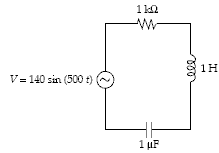A design requires a material that must operate up to temperature of 200°C (392°F), have a high resistance to deformation, a high strength, a high resistance to fracture, and a low density. Highest performance is the most important design criteria. Which of the following materials is most likely to best satisfy the design requirements?
(a) Alumina ceramic
(b) Low-carbon steel
(c) Polyethylene
(d) Graphite-reinforced epoxy
(d) Graphite-reinforced epoxy
You might also like to view...
Determine the impedance for the circuit
?

?
a.
600 ?
b.
1200 ?
c.
1800 ?
d.
2300 ?
e.
1100 ?
Refer to Figure 6-13 Block A has a mass of 5.00 kg, block B has a mass of 3.00 kg and block C has a mass of 2.00 kg. The pulleys are ideal and there is no friction between block B and the table. What is the tension in the string connecting blocks B and C?
A. 20.6 N B. 13.7 N C. 38.3 N D. 25.5 N E. 34.3 N
The most significant difference between the astronomical theories of Ptolemy and Copernicus is
A) Ptolemy's is not based on scientific evidence, while Copernicus's is. B) Ptolemy's theory does away with many of the complexities of the Copernican theory. C) Ptolemy's theory is sun-centered, whereas Copernicus's is Earth-centered. D) Ptolemy uses circular planetary orbits while Copernicus uses elliptical orbits. E) Ptolemy's theory is Earth-centered, whereas Copernicus's is sun-centered.
Our best data about the surface topography of Venus has come from:
A) Magellan radar data and radar observations of the planet from Earth. B) spacecraft flybys like Mariner 2 and visual observations of the planet. C) radio and visual observations. D) orbiter photos from Pioneer Venus Orbiter. E) the three flybys of Mariner 10.